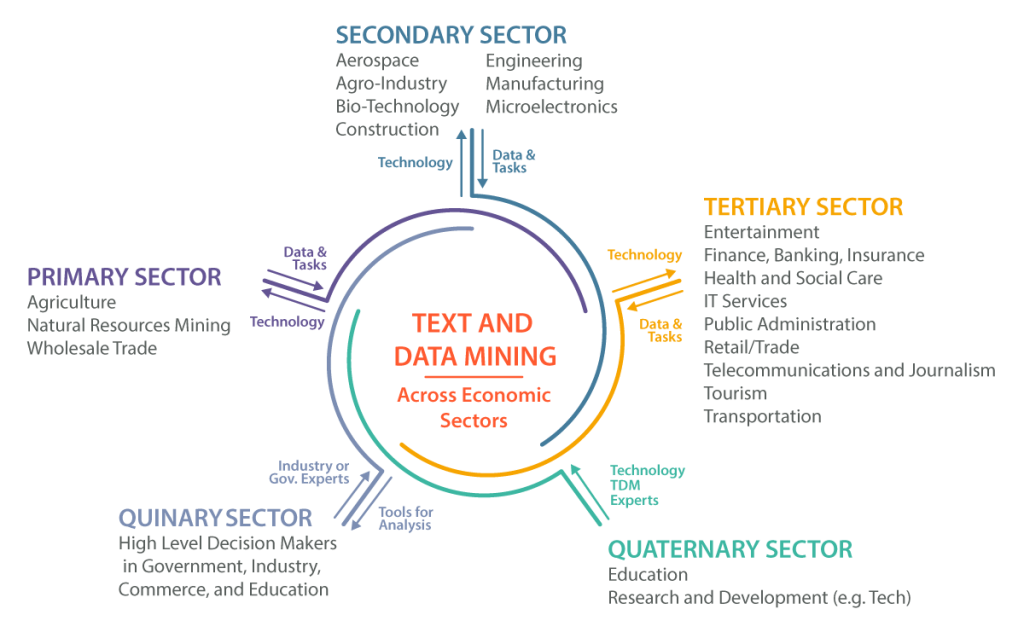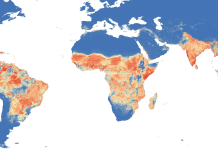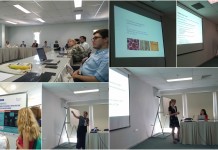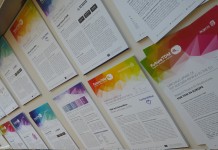Since the beginning of humanity, the development of novel technologies sometimes had a significant impact on the structure of society and on its distribution of employment. Agriculture and the extraction of natural resources fits into the primary sector, as this is a primary type of human joint effort to produce food for survival. The invention of machines and elaborated tools led to the development of the secondary sector, which has evolved into complex machinery engineering, constructions, and space exploration. The third sector comprises all the services that society members deliver to each other, varying from retail to transportation, and from medical healthcare support to entertainment.
Until recently this three components structure represented most of the societies in the world. However, the growth of data-driven business, services and research have arguably created a novel type of knowledge-based economy, where data, information, and knowledge have become valuable commodities in themselves.1 Thus, recently the research that supports knowledge sharing and growth, as well as education of the professionals that can carry out these activities, are put aside as the quaternary sector of economy. Moreover, the high-level decision makers in governments, large industry companies and education, who have the potential to shape the future of the entire sectors with their vision and following decisions, are placed into a separate, quinary sector.
We live in the era of knowledge-based economy, where information, data, and knowledge have become valuable commodities in themselves.

The primary, secondary, and tertiary sectors follow roughly the same type of interaction with TDM technologies. These sectors represent sources of all possible types of data that could be made available for mining, and at the same time, have tasks and challenges that require smart solutions. The quaternary sector is particularly central for TDM development and implementation, as it produces the TDM experts and advances the technology itself. Experts at the decision-maker level use TDM tools to test and prove their visions of economic development, as well as to hypothesize where certain decision will lead to, and to measure and assess this progress.
Primary sector
Making the best use of limited natural resources with a constantly growing population is one of humanity’s ultimate challenges. Taking on the challenge requires the understanding of changing patterns in climate and environment; TDM has the potential to discover such patterns automatically from data.
Example: Agronow is a company that mines agricultural scientific and technological information, so that various users can get access to it to acquire better understanding of the crop growing, to follow the food providers availability and accessibility.
Secondary sector
Any large-scale manufacturing plant or distributed network of pipelines is packed with various types of sensors that produce a continuous stream of measurements that are crucial for maintenance analysis, such as temperatures, pressure levels, leak detections, etc. When analysed on a large scale, this information offers a basis for discovering and understanding strategies for cost savings and safety measures.
Example: Columbia Pipeline Group implements predictive analytics tools from GE and Accenture to analyze pipeline integrity across 15 000 miles of interstate and real-time data.
Tertiary sector
The sector of provided services embraces TDM at different pace, depending on the TDM expertise and awareness in the field, big data availability, and sensibility of this data in terms of privacy, as much more personal data is mined within this sector.
Companies allocate great effort to the interaction with their existing customers, as this allows them to monitor customers’ feedback on the products, and at the same time to profile customers for further targeted product promotion.
On the other hand, information about users’ Internet surfing behaviour is gathered in form of click logs, website views and search queries. Once this data is categorised and profiled, the advertising network industry can match the right advertisement from the right company to the suitable client profile. Sentiment analysis of customer comments in global social networks, such as Twitter and internet forums, allow companies to track customer interest in their products, as well to use these channels for targeted advertisement of services and products.
Examples: Medical treatments and predictions suggested by artificial intelligence and TDM are being integrated in decision support systems for doctors (e.g. Babylon in the UK, IBM Watson in the USA). Such systems, powered by AI, can help to lower the costs in regions with a shortage of specialty providers.
Banks and insurance companies use TDM to build consumer profiles and develop automatic classifiers to determine eligibility for financial products, and to set insurance premiums. Customer parameters can include diverse types of information gathered from different sources, ranging from consumers’ zip codes, employment background, educational history, to their shopping history, social media usage and friendship network.2
Quaternary sector
This information and knowledge-rich sector focuses on knowledge gathering, processing, and creation, via research practices and teaching of society members. TDM algorithms are represented in this sector as both the subject of research and a set of tools that enable research.
Examples: TDM can be used to support researchers with mining of scientific publications, allowing them to discover trends and novel connections between shared data and experimental results, possibly across disciplines.
Quinary sector
Funders and high-level decision makers rely on their general visions of technology and society development paths, as well as the impact metrics that assess potential economic, political, and societal value. TDM can be of use for these experts when they need to mine the current status of affairs, and to predict the outcomes of diverse types of interventions. Moreover, sentiment analysis of social networks activities can provide them with fast feedback from the population on actions taken.
Featured image credit CC-BY Got Credit.
1 https://www.oecd.org/sti/sci-tech/1913021.pdf
2 https://www.ftc.gov/system/files/documents/reports/big-data-tool-inclusion-or-exclusion-understanding-issues/160106big-data-rpt.pdf









